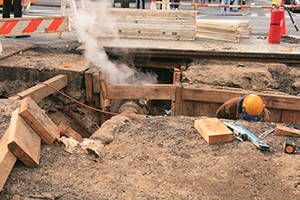Working Safely in Trenches

According to the Occupational Safety and Health Administration (OSHA), trenching kills forty workers every year, on average. Proper procedures in trenching operations can save lives and reduce worker exposure to cave-ins, falling loads, hazardous atmospheres, and hazards from mobile equipment.
OSHA standard require trenches and protective systems be inspected daily and as conditions change by a competent person before work begins. They also provide the following guidelines:
Never enter a trench unless:
- Cave-in protection measures are in place
- There’s a safe way to enter and exit
- Equipment and materials are away from the edge
- It is free of standing water and atmospheric hazards
Prevent trench collapses:
- Trenches 5’ deep or greater require a protective system
- Trenches 20’ deep or greater require a protective system design by a registered professional engineer
Protective systems for trenches are safer when you SLOPE, SHORE, and SHIELD:
- SLOPE or bench trench walls by cutting back the trench wall at an angle inclined away from the excavation.
- SHORE trench walls by installing aluminum hydraulic or other types of supports to prevent soil movement.
- SHIELD trench walls by using trench boxes or other types of supports to prevent soil cave-ins.



